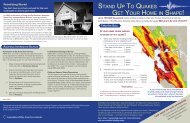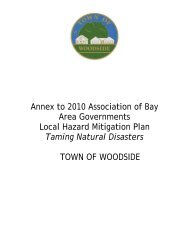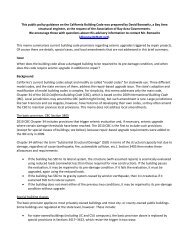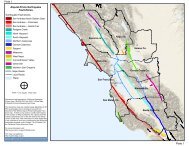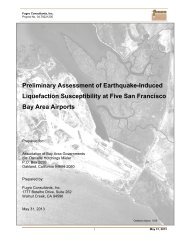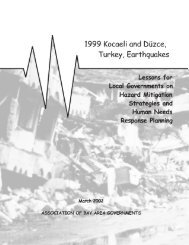<strong>Safe</strong> <strong>Enough</strong> <strong>to</strong> <strong>Stay</strong>Library of Congress Prints <strong>and</strong> Pho<strong>to</strong>graphs DivisionEmergency shelter after the San Francisco’s 1906 earthquake (<strong>to</strong>p) <strong>and</strong> Kobe’s 1995 earthquake (bot<strong>to</strong>m).flickr user kosmosxipofederal rental vouchers <strong>to</strong> displaced residents <strong>to</strong> pay for existinghousing resources such as vacant rental units <strong>and</strong> hotel <strong>and</strong> motelrooms in <strong>and</strong> near San Francisco; second, aiding in the provisionof traditional interim-housing forms such as Federal EmergencyManagement Agency (FEMA) trailers that might be located in front ofdamaged residences, public parks, the rights-of-way of wider streets,or any larger tracts of undeveloped l<strong>and</strong>s; <strong>and</strong> third, using innovativeforms of interim housing, which might include cruise ships dockedalong the waterfront or vacant commercial space.All of these options present problems for San Francisco. Evenwithout a disaster, there is a limited supply of vacant housing in SanFrancisco, <strong>and</strong> using the city’s hotels <strong>to</strong> house displaced residentswill need <strong>to</strong> be balanced with accommodating workers who come <strong>to</strong>repair the city <strong>and</strong> <strong>to</strong>urists who help <strong>to</strong> res<strong>to</strong>re the economy. Thereare few undeveloped spaces in the city, <strong>and</strong> filling parks <strong>and</strong> streetswith trailers for <strong>to</strong>o long will present transportation, recreation <strong>and</strong>economic challenges.If existing housing, hotel space or l<strong>and</strong> for trailers is not available,then the region’s disaster housing plans call for relocating displacedresidents <strong>to</strong> nearby counties <strong>and</strong> cities. 5 However, in a regionaldisaster such as a magnitude 7.2 earthquake, neighboring cities <strong>and</strong>counties will also be struggling <strong>to</strong> house displaced residents, addingpressure <strong>to</strong> the region’s housing s<strong>to</strong>ck. Thus, San Franciscans mayface the same challenges as New Orleanians did after HurricaneKatrina <strong>and</strong> may have <strong>to</strong> travel far <strong>to</strong> find available housing.After Katrina, New Orleans’ displaced residents had <strong>to</strong> movetemporarily <strong>to</strong> Ba<strong>to</strong>n Rouge, Atlanta, Hous<strong>to</strong>n <strong>and</strong> Dallas, all greatdistances from the city. This made it difficult for residents <strong>to</strong> keep theirjobs, repair <strong>and</strong> rebuild their homes, <strong>and</strong> res<strong>to</strong>re their communities.In 2011, San Francisco’s Department of Emergency Servicesinitiated a post-disaster interim-housing planning process <strong>to</strong> set localpriorities for interim housing <strong>and</strong> determine how many people couldrealistically be accommodated in the various interim-housing options.The city’s objectives for the post-disaster interim-housing planningeffort 6 are <strong>to</strong>:• Keep residents in their homes• If not in their homes, then keep residents in their neighborhoods• If not in their neighborhoods, then keep residents in the city• If residents leave the city, then have a plan for their return8 SPUR Report > January 2012
After a magnitude 7.2 earthquake on the San Andreas Fault,approximately 85,000 households (about 25 percent of the city’shouseholds 7 ) could need interim housing for several months,gradually decreasing <strong>to</strong> 45,000 households (approximately 13percent) by two years after the earthquake, with up <strong>to</strong> 15,000households (approximately 5 percent) requiring interim housing forup <strong>to</strong> five years. 8 Clearly, emergency-shelter beds will not be able <strong>to</strong>accommodate this scope of displaced population in the short term,<strong>and</strong> interim-housing options will not easily accommodate such largenumbers for the months <strong>and</strong> years that housing takes <strong>to</strong> be repaired<strong>and</strong> replaced. The insufficiencies of both these capacities suggest thecity should strive <strong>to</strong> keep as many residents as possible in their ownhomes after a large earthquake. While no specific number emerges,our review supports SPUR’s long-term goal of 95 percent of residentsbeing able <strong>to</strong> shelter in their current homes.Other performance metrics related <strong>to</strong> disasterresilienceSan Francisco is not the only community looking at its resilience <strong>and</strong>capacity <strong>to</strong> rebound following future disasters. Both in the UnitedStates <strong>and</strong> around the world, researchers <strong>and</strong> policymakers areleading efforts <strong>to</strong> develop the means of measuring <strong>and</strong> moni<strong>to</strong>ringcommunity resilience. While there is no single set of establishedindica<strong>to</strong>rs or frameworks for quantifying disaster resilience, thereis growing consensus that resilience is a multifaceted conceptwith social, economic, institutional, infrastructural, ecological <strong>and</strong>community dimensions. 9 Several sets of resilience indica<strong>to</strong>rs orattributes have been developed as a means of comparing resiliency ina community over time or measuring recovery progress <strong>and</strong> outcomesfollowing a disaster. 10 Most consider community functions —infrastructural, economic <strong>and</strong> social — in a manner similar <strong>to</strong> SPUR’sResilient City recovery performance indica<strong>to</strong>rs; however, none are asspecific as SPUR’s goals (e.g., 95 percent of residents able <strong>to</strong> shelterin place after the expected earthquake).All of the metrics examined recognize that housing plays an important5 Regional Catastrophic <strong>Earthquake</strong> Interim Housing Plan: Annex <strong>to</strong> theSan Francisco Bay Area Regional Emergency Coordination Plan (CaliforniaEmergency Management Agency, 2011).6 Johnson, Laurie <strong>and</strong> Lucas Eckroad, Summary Report on the City <strong>and</strong> Countyof San Francisco’s Post-Disaster Interim Housing Policy Planning Workshop.(San Francisco Department of Emergency Management, July 11, 2001).7 There are approximately 330,000 households in San Francisco. The estimateof 85,000 households comes from analysis of CAPSS Hazus output data. SeeFigure 4.8 Johnson, Laurie <strong>and</strong> Lucas Eckroad, Summary Report on the City <strong>and</strong> Countyof San Francisco’s Post-Disaster Interim Housing Policy Planning Workshop (SanFrancisco Department of Emergency Management. July 11, 2001.)9 Peacock, Walter G., William H. Hooke, Susan L. Cutter, Stephanie E. Chang<strong>and</strong> Philip R. Berke, Toward a Resiliency <strong>and</strong> Vulnerability Observa<strong>to</strong>ry Network:RAVON (Texas A&M University Hazard Reduction <strong>and</strong> Recovery Center, Collegeof Architecture, 2008); National Research Council, Committee on Private-PublicSec<strong>to</strong>r Collaboration <strong>to</strong> Enhance Community Disaster Resilience, BuildingDisaster Resilience Through Public-Private Collaboration. (Washing<strong>to</strong>n, DC:National Academies Press, 2010).role in community resilience <strong>and</strong> that it is linked <strong>to</strong> many otheraspects of recovery. However, none clearly state how robust acommunity’s housing needs <strong>to</strong> be <strong>to</strong> achieve resiliency, <strong>and</strong> we c<strong>and</strong>raw no conclusions from the resilience literature about whetherSPUR’s performance target for housing is reasonable.Recent comparable disastersPerhaps the best way <strong>to</strong> investigate whether a goal of 95 percentshelter in place is reasonable for San Francisco is <strong>to</strong> consider howother communities fared after major disasters. Every disaster isdifferent, but reviewing case studies of recovery from similar citiesprovides insights in<strong>to</strong> what San Francisco might experience aftera damaging earthquake. By looking at these case studies, we areinterested in examining how damage <strong>to</strong> housing affected the overallrecovery of each community. We are also trying <strong>to</strong> underst<strong>and</strong> no<strong>to</strong>nly how quickly a city or region can rebuild housing units, butwhether the rebuilding serves the population that was displaced bythe disaster or serves a new population. As such, we are attempting<strong>to</strong> correlate housing damage with outmigration after the disaster.Some past events are more relevant <strong>to</strong> San Francisco becausethey were urban events in developed countries, where the qualityof construction <strong>and</strong> housing conditions were similar <strong>to</strong> those in anAmerican city like San Francisco. Other events, due <strong>to</strong> the scale ofthe event or the circumstances in the locale, were not appropriatecomparisons. Figure 1 (page 10) summarizes the impacts fromseveral disasters. While the number of uninhabitable housing unitsranges between 1 <strong>and</strong> 50 percent in these examples, it is clear thateven when the loss of housing units is less than 10 percent, the time<strong>to</strong> repair or rebuild uninhabitable housing units is long <strong>and</strong> can inhibitrecovery. 11 In the absence of adequate interim housing, outmigrationis inevitable <strong>and</strong> the loss of population will impact the local economy<strong>and</strong> overall recovery. We see permanent loss of population, <strong>and</strong> theaccompanying social <strong>and</strong> economic impacts, in communities wherehousing losses are as low as 5 <strong>to</strong> 10 percent.10 Literature reviewed includes: Bruneau, Michel, Stephanie E. Chang, RonaldT. Eguchi, George C. Lee, Thomas D. O’Rourke, Andrei M. Reinhorn, MasanobuShinozuka, Kathleen Tierney, William A. Wallace <strong>and</strong> Detlof von Winterfeldt,“A Framework <strong>to</strong> Quantitatively Assess <strong>and</strong> Enhance the Seismic Resilience ofCommunities,” <strong>Earthquake</strong> Spectra 19 (4) (November 2003): 733–752; Towarda Common Framework for Community Resilience. (Oak Ridge, TN: Community<strong>and</strong> Regional Resilience Institute, 2009); Cutter, Susan L., Chris<strong>to</strong>pher G. Bur<strong>to</strong>n<strong>and</strong> Chris<strong>to</strong>pher T. Emrich, “Disaster Resilience Indica<strong>to</strong>rs for BenchmarkingBaseline Conditions,” Journal of Homel<strong>and</strong> Security <strong>and</strong> EmergencyManagement 7 (1) (2010): Article 51, 1–20; LeDuc, Andre, EstablishingMitigation as the Corners<strong>to</strong>ne for Community Resilience (Eugene, OR: Partnersfor Disaster Resistance <strong>and</strong> Resilience, 2006); Miles, S. <strong>and</strong> Stephanie E.Chang, “Modeling Community Recovery from <strong>Earthquake</strong>s,” <strong>Earthquake</strong> Spectra22 (2) (May 2006): 439–458; Norris, Fran H., S.P. Stevens, B. Pfefferbaum,K.F. Wyche <strong>and</strong> R.L. Pfefferbaum, “Community Resilience as a Metaphor,Theory, Set of Capacities, <strong>and</strong> Strategy for Disaster Readiness,” AmericanJournal of Community Psychology 41 (1–2) (March 2008): 127–150; Twigg,John, Characteristics of a Disaster-Resilient Community: A Guidance Note(Aon Benfield UCL Hazard Research Centre, November 2009) www.abuhc.org/Publications/CDRC%20v2%20final.pdf11 The recovery time varies depending on what kind of housing was lost (e.g.,apartments <strong>and</strong> low-income units typically take longer than middle-incomesingle-family homes).SPUR Report > January 2012 9



